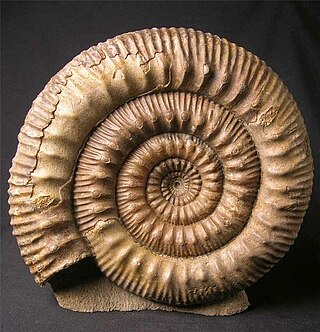
Ammonoids are extinct spiral shelled cephalopods comprising the subclass Ammonoidea. They are more closely related to living coleoids than they are to shelled nautiloids. The earliest ammonoids appeared during the Devonian, with the last species vanishing during or soon after the Cretaceous–Paleogene extinction event. They are often called ammonites, which is most frequently used for members of the order Ammonitida, the only remaining group of ammonoids from the Jurassic up until their extinction.

Stephanoceras is an extinct genus of Stephanoceratoid ammonite which lived during the Bajocian. It is the type genus of the family Stephanoceratidae.
Alocolytoceras is a lytoceratid ammonite with whorls that pass during growth from round to oval, rounded-quadrate, or compressed; with about 19 deep constrictions per whorl, with as many as 21 sharp ribs in between. The shell is evolute. All whorls are visible from either side.
Anatropites is a genus of ammonite in the ceratitid family Tropitidae with spines instead of nodes on the umbilical shoulder, at least in early whorls. Ceratitids are mostly Triassic ammonoid cephalopods.

Aspidoceras is an extinct ammonoid cephalopod genus belonging to the family Aspidoceratidae.

Balatonites is a genus of extinct cephalopods belonging to the ceratitid family Balatonitidae. There are at least four known species: B. balatonicus, B. oyama, B. shoshonensis, and B. zitteli.

Barremites is an ammonoid cephalopod genus belonging to the family Desmoceratidae, that lived during the Hauterivian and Barremian stages of the Early Cretaceous.
Uhligella is an extinct cephalopod genus from the Early Cretaceous, belonging to the ammonoid subclass and included in the Desmoceratidae.

Ceratitida is an order that contains almost all ammonoid cephalopod genera from the Triassic as well as ancestral forms from the Upper Permian, the exception being the phylloceratids which gave rise to the great diversity of post-Triassic ammonites.

Lytoceratina is a suborder of Jurassic and Cretaceous ammonites that produced loosely coiled, evolute and gyroconic shells in which the sutural element are said to have complex moss-like endings.

Ammonitina comprises a diverse suborder of ammonite cephalopods that lived during the Jurassic and Cretaceous periods of the Mesozoic Era. They are excellent index fossils, and it is often possible to link the rock layer in which they are found to specific geological time periods.

Peltoceras is an extinct ammonite genus from the aspidoceratid subfamily Peltoceratinae that lived during the later part of the Middle Jurassic.
Otoidtidae: stephanoceratoid ammonitina from the early Middle Jurassic that begin as cadicones but become more planualte with age; derived from the Hammitoceratidae (Hildoceratoidea), probably through Erycites by way of Abbasites.

Clyclolobus is a smooth, essentially involute subdiscoidal goniatitid ammonoid that has sutures with a bifurcate ventral lobe, flared outwardly at the end, in which the halves may be secondarily trifurcated, ending in sharp, narrow projections. Lateral sutural elements follow an acuate line that swings first to the front, then sharply to the rear before becoming hidden by the next whorl. Saddles are narrow, cumulous in appearance with short, irregular, rounded sub-endings. Ventro-lateal lobes are trifurcate with pointed, thorn-like projections.

Forresteria is an extinct genus of cephalopod belonging to the subclass Ammonoidea. They flourished during the late Turonian and early Santonian of the Late Cretaceous, and were global in extent. Forresteria alluaudi and Forresteria hobsoni are considered marker fossils for the lower Coniacian in the American West.

Lytoceratidae is a taxonomic family of ammonoid cephalopods belonging to the suborder Lytoceratina, characterized by very evolute shells that generally enlarge rapidly, having whorls in contact but mostly overlapping very sightly, or not at all.
Bisatoceras is a late Paleozoic Ammonoidea, a member of the goniatitid family Bisatoceratidae.
Parapopanoceras is a ceratitid ammonite with a small, smooth, very involute and moderately globose shell that lived during the middle Triassic.
Palaeophyllites is a genus of ammonoids from the Lower Triassic and a contemporary of the related ussuritid Eophyllites.
Bredyia is a genus of ammonites from the lower part of the Middle Jurassic, found in Europe and North America.










